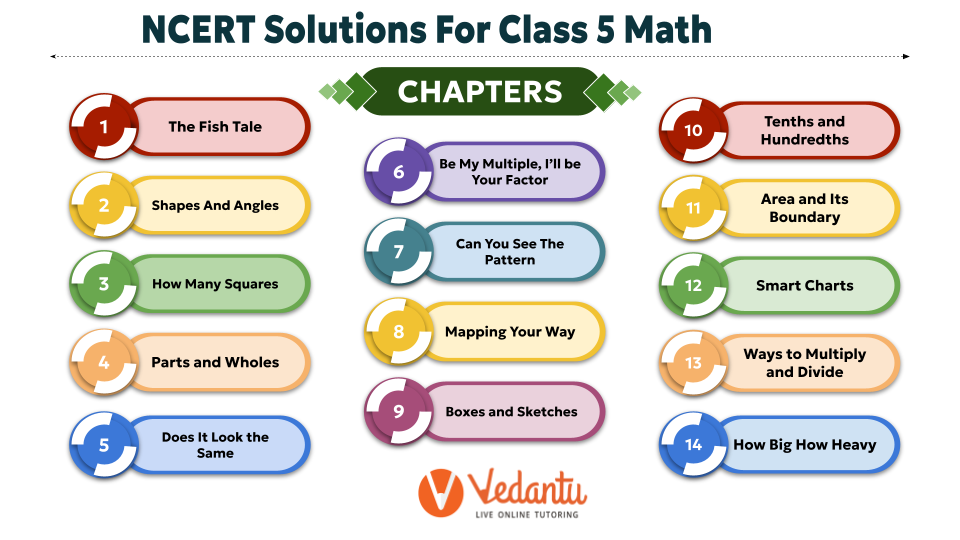NCERT Solutions For Class 5 Maths All Chapters - 2025-26
FAQs on NCERT Solutions For Class 5 Maths All Chapters - 2025-26
1. How many chapters are there in the NCERT Class 5 Maths syllabus for the 2025-26 session?
The NCERT Class 5 Maths syllabus for the academic year 2025-26 comprises a total of 14 chapters. These chapters cover a range of topics from basic arithmetic to geometry and data handling, designed to build a strong mathematical foundation.
2. What are the main topics I need to study using the NCERT Solutions for Class 5 Maths?
The NCERT Solutions for Class 5 Maths cover all topics as per the CBSE 2025-26 syllabus. Key areas of study include:
Number Concepts: Large numbers, The Fish Tale, Shapes and Angles.
Operations: Parts and Wholes (Fractions), Does it Look the Same? (Symmetry), Be My Multiple, I'll Be Your Factor.
Measurement: How Many Squares? (Area), Tenths and Hundredths (Decimals), Area and its Boundary.
Geometry and Patterns: Mapping Your Way, Boxes and Sketches, Smart Charts.
Applied Maths: Ways to Multiply and Divide, How Big? How Heavy? (Volume).
3. Is it really necessary to solve every single question from the NCERT textbook for Class 5 Maths?
Yes, it is highly recommended. Solving every question in the NCERT textbook ensures a thorough understanding of all concepts and their applications. Exam questions are often based directly on the patterns and problem types found in the textbook. Using the NCERT solutions to verify your methods helps reinforce learning and prepare you for any question that might appear in the exam.
4. How do NCERT Solutions provide step-by-step answers for Class 5 Maths problems?
NCERT Solutions are designed to explain the correct methodology as per CBSE guidelines. Each solution breaks down a problem into a logical sequence of steps. This includes identifying the given data, choosing the correct formula or operation, performing the calculation, and presenting the final answer clearly. This approach helps you understand how to arrive at the solution, not just what the final answer is.
5. How can using Class 5 Maths NCERT Solutions help me score better marks?
Using NCERT Solutions helps improve scores by ensuring you learn the step-by-step method approved by CBSE, for which marks are often awarded. Regularly practising with these solutions helps you manage time better, reduce calculation errors, and gain confidence in solving different types of problems, leading to better performance in exams.
6. I find word problems in Class 5 Maths very confusing. How can NCERT Solutions help with this?
NCERT Solutions are particularly useful for complex word problems. They demonstrate how to deconstruct the problem, identify key information, and translate the words into a mathematical equation. By following the solved examples, you learn the thinking process required to tackle these questions, which improves your analytical and problem-solving skills for any word problem you encounter.
7. What are the common mistakes students make in Class 5 Maths, and how can solutions help prevent them?
Common mistakes in Class 5 Maths include calculation errors, misunderstanding concepts like area and perimeter, and confusion with fractions or decimals. NCERT Solutions help by providing a reliable reference to cross-check your answers and methods. When you see a problem solved correctly step-by-step, you can identify precisely where your own method went wrong and correct your understanding, preventing the same mistake in the future.
8. Why is it important to understand the method and not just copy the answer from NCERT Solutions?
Simply copying an answer does not build understanding. The main purpose of NCERT Solutions is to teach the 'how' and 'why' behind a problem. Understanding the method builds your logical reasoning and problem-solving skills, which are crucial for higher classes. Exams test your ability to apply concepts, and this is only possible if you have practised the methods yourself rather than memorising the final answers.
9. How do the problems in NCERT Class 5 Maths prepare me for future classes?
The concepts introduced in Class 5 are foundational for middle school mathematics. Topics like factors, multiples, fractions, decimals, and area form the building blocks for more advanced topics like algebra and geometry. By mastering these basics with the help of NCERT Solutions, you ensure you have a strong and clear foundation, making it easier to grasp complex subjects in Class 6 and beyond.

























